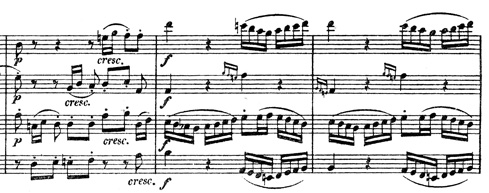Ludwig van Beethoven
String Quartet in B♭ major, op.130
Media Review / Comparison
2012-04-11 — Original posting (on Blogger)
2012-11-12 — Metronome table added, Endellion String Quartet added
2013-02-05 — Added results of a radio discussion / comparison, featuring 5 of the recordings below
2013-08-07 — New standard layout applied
2014-11-07 — Re-posting as is (WordPress)
2016-07-09 — Brushed up for better readability
Table of Contents
- Introduction / The Recordings
- The Composition
- Timing Comparison
- Comments on the Individual Recordings
- Guarneri String Quartet (1969)
- Amadeus Quartet (1962)
- Endellion String Quartet (2006)
- Quartetto Italiano (1969)
- LaSalle Quartet (1972)
- Alban Berg Quartett (1983)
- Emerson String Quartet (1997)
- Busch Quartett (1941)
- Melos Quartett Stuttgart (1985)
- Takács Quartet (2004)
- Leipziger Streichquartett (2006)
- Artemis Quartet (2009)
- Hagen Quartett (2001)
- Addendum
Introduction / The Recordings
Here’s another note on the recordings of Beethoven’s string quartets in my music collection, about the quartet in B♭ major, op.130 — references to the CDs are given at the bottom of the respective section, or in one of the related postings, or see the summary on the postings covering Beethoven’s String Quartets. Here’s a short list of the recordings in this comparison, in alphabetic order:
- Alban Berg Quartett (1983)
- Amadeus Quartet (1962)
- Artemis Quartet (2009)
- Busch Quartet (1941)
- Emerson String Quartet (1997)
- Endellion String Quartet (2006)
- Guarneri String Quartet (1969)
- Hagen Quartett (2001)
- LaSalle Quartet (1972)
- Leipziger Streichquartett (2006)
- Melos Quartett (1985)
- Quartetto Italiano (1969)
- Takács Quartet (2004)
The Composition
The String Quartet in B♭, op.130, by Ludwig van Beethoven (1770 – 1827) features the following movements:
1. Adagio, ma non troppo (3/4) — Allegro (4/4)
One little detail: in bars 42 and 43 (Allegro) the second violin has three acciaccaturas; for the classical period (as opposed to baroque practice), these acciaccaturas must be performed preceding the beat, i.e., the first and third such ornament should precede the sixteenth figure in the first violin and should be clearly audible:
Another little detail: the first Allegro ends in a staccato chord in bar 21: formally, that chord falls under the Tempo I (3/4) label, hence the question is whether that chord ought to be played in Tempo I (i.e., Adagio ma non troppo), or whether it should be interpreted as pure ending chord for the preceding Allegro (4/4) section. That latter option is clearly what the Leipziger Streichquartett uses. In their interpretation, that chord is very short, staccato and allegro, almost making the Tempo I start on the second beat only (not quite true, as they extend the pause slightly).
All other ensembles play this chord broader, i.e., as staccato and adagio. With this I don’t want to criticize one or the other option — I don’t think there is a “proper” solution here, i.e., this can be interpreted both ways: it depends on how much one also regards this chord as the opening of the Tempo I section.
An Analogy in Beethoven’s Symphony No.9
This reminds me of a similar case in Beethoven’s Ninth Symphony: in the last movement, the “-fun-ken” in the very last “Götterfunken” sung by the choir is the ending of a Maestoso section (3/4, 1/4=60), but falls into the first bar of the final Prestissimo (4/4). From the choir’s view, one would like to finish that last word in Maestoso-manner, even though the notation does not support this. I have participated in performances of this piece a couple times — the conductors tried to escape that question, or regarded it as unimportant — and overall, I think it isn’t really crucial: either version can sound “right”.
Repetition Marks
A word on the repetition marks: if Beethoven wrote repetition marks around the exposition in his late quartets (where he certainly long stopped caring about conventions!), then that’s certainly what he meant — and especially with a movement as complex and diverse as this one, I think it helps capturing the “big structure”, even though it lengthens the movement considerably. Especially older interpretations tend to ignore the repetition signs (Amadeus Quartet, Alban Berg Quartet, Guarneri String Quartet, LaSalle Quartet), the Busch Quartet may have a valid excuse with the maximum track duration on old 75 r.p.m. records.
2. Presto (alla breve, 2/2) — L’istesso tempo (6/4)
As the notation is alla breve and 6/4, the “istesso tempo” does of course not apply to the quarter notes, but to the counting units, i.e., 1/2 and 3/4. In the 6/4 part. The ending scales in the first violin reach extreme heights (for that period) — and appear to be quite a challenge in the intonation!
3. Andante con moto, ma non troppo; poco scherzoso (4/4)
The Andante con moto implies “walking, moving forward” — though the “con moto” is at the same time limited by “ma non troppo” — and on top of that there’s the “Poco scherzoso“, which probably does not mean “little humorous”, but “a little humorous”: quite a puzzle, overall! The Guarneri String Quartet plays 1/4 = 49, which to me is clearly too slow — but the span to the fastest tempo isn’t all that big (Busch Quartet, 1/4 = 68), as faster tempi prohibit articulating the short notes (see the score excerpt above).
4. Alla danza tedesca: Allegro assai (3/8)
There is an extreme spread in the tempo in these interpretations, ranging from 1/8 = 135 (Guarneri String Quartet) up to 1/8 = 220 (Busch Quartet): that “German dance” is not a baroque Allemande (which would be in even measures anyway), but a kind of fast, light waltz. Even if one interprets “German” as “rather heavy” (?), the movement should retain some dance character — and, after all, there’s also the annotation Allegro assai!
5. Cavatina: Adagio molto espressivo (3/4)
A Cavatina (a small Cavata) is a simple vocal piece in an opera (simpler and less demanding than an aria). This implies that one should keep an eye on the melodies in this movement, i.e., it should not be played so slow that the listener loses track of the melody. The annotation is Adagio molto espressivo — but the movement is written in 3/4 measures: counting should not be on the eighths.
Also, most of the movement is p and sotto voce. Another hint is found in a section annotated “Beklemmt” (distressed) that sounds like a Recitativo accompagnato — “talking”, not dragging, and not extremely slow (the first violin may use “hesitant articulation” to express distress — but that distress is resolved after a few bars.
6. Finale: Allegro (2/4)
Beethoven’s original plan was to publish the quartet op.130 with the Great Fugue (now op.133) as final movement, but (some of) his friends argued that with this monster Finale the quartet would hardly be accepted & understood by the audience; they allegedly also argued that the Great fugue is such a great composition on its own that it deserved being published separately.
We don’t know whether Beethoven had a hard time accepting this proposal, or whether that’s something that he had already considered anyway (my feeling is that had he had strong objections, he would hardly have accepted that proposal) — in any case, the quartet op.130 went to publication with a new final movement, and the Great Fugue was published separately, as op.133, and this is also the arrangement that I chose for this comparison. The new Finale is certainly not nearly as “heavy” as the Great Fugue — but that does not imply that it is a composition oF minor value!
Stand-Alone Movements
There’s a little more to this, of course. The main reason why I chose to review op.130 with the “add-on final movement” rather than the Great Fugue (op.133) as last movement, besides the arguments mentioned above, is that the “Finale: Allegro” is hardly a stand-alone piece and is best heard together with the rest of op.130 (while the Great Fugue op.133 certainly can be listened to just by itself and is also often performed this way). Adding the new Finale movement after the Great Fugue certainly does not make sense, and neither does inserting it between the Cavatina and the Great Fugue.
Cross-Relations with the Great Fugue op.133
On the other hand I don’t want to deny that there are ties that link the Great Fugue to op.130 other than just the common tonality (which is a rather weak argument, given the vast amount of modulation in these pieces): the first movement of op.130 anticipates motifs that are used in the Great Fugue, namely in this strange unison passage at the end of the exposition and just prior to the Coda:
In the context of the first movement this sounds totally unrelated, a strange insertion. As it turns out, that motif is used in the Great Fugue, op.133, in the Meno mosso e moderato, bars 17 – 25:
and also in subsequent Meno mosso e moderato sections, e.g.:
This obvious relationship could serve as a valid argument for combining the Great Fugue op.133 with the first 5 movements of op.130 — but as discussed above, I decided to stay with the version / arrangement as published by Beethoven, and to review op.133 in a separate blog entry.
Timing Comparison
As one of the few things that one can actually “measure” in music performances, I’m giving the approximate metronome numbers for each of the movements in the text below. As these numbers are spread over the text, I felt it would help if I collected them in a table, shown below. I have used color coding to indicate relative rates: white would be the average tempo, blue fields are slower tempi, green indicates faster-than-average performances (where the strength of the color indicates the amount of deviation from the average). Some ensembles prefer slower tempi, others are faster throughout, some are “mixed bags” (click on table for full size view):
Comments on the Individual Recordings
The order of the interpretations is not chronological (neither by recording / publishing date nor by purchase date), but follows my personal, subjective rating, my preferred recordings shown last:
Guarneri String Quartet (1969)
Beethoven: The Late String Quartets, opp. 127, 130-133, 135
RCA Victor / BMG Classics 60458-2-RG (stereo, 3 CD); ℗ / © 1990

Recorded in 1969, with Arnold Steinhardt, John Dalley, Michael Tree, David Soyer — for general comments see op.127.
Notes on the Movements
1. Adagio, ma non troppo (3/4) — Allegro (4/4)
10’05” (exposition not repeated); 1/4 = 37 (Adagio ma non troppo) — 130 (Allegro)
Articulation not always following score, rather “fuzzy” in general, lacking transparency; concept?
2. Presto (alla breve, 2/2) — L’istesso tempo (6/4)
1’58”; 1/2 = 166 (Presto) — 3/4 = 162 (L’istesso tempo)
The beginning (alla breve) is good — unfortunately, in the 6/4 part, intonation and articulation are not clean.
3. Andante con moto, ma non troppo; poco scherzoso (4/4)
7’26”; 1/4 = 49
This is too slow, at most an Andante on the eighths, but not on 4/4, let alone con moto. And where’s the scherzoso aspect? This interpretation sounds rather melancholic and has lengths — and the nervous vibrato does not help.
4. Alla danza tedesca: Allegro assai (3/8)
3’57”; 1/8 = 135
Very slow, melancholic and heavy — a dance?? And where’s the Allegro assai?
5. Cavatina: Adagio molto espressivo (3/4)
7’25”; 1/8 = 56
Too uniform overall, too much legato, too smooth — and with a very uniform, excessive vibrato, too many portamenti.
6. Finale: Allegro (2/4)
8’25” (exposition not repeated); 1/4 = 136
Sometimes superficial in the articulation. They use extreme agogics: the second theme is much slower — even when the score says “a tempo“; they tend to use strong ritardandi (again, without appropriate support by the score), the musical flow is often totally disrupted.
| Recommendation: | No. |
| Rating: | 1.8 (2 / 2 / 1 / 2 / 2 / 2) |
Amadeus Quartet (1962)
Beethoven: The String Quartets (opp. 18, 59, 74, 95, 127, 130-133, 135)
DG 463 143-2 (stereo, 7 CD); ℗ 1962 / © 1974

Recorded in 1962, with Norbert Brainin, Siegmund Nissel, Peter Schidlof, Martin Lovett — for general comments see op.18/1.
Notes on the Movements
1. Adagio, ma non troppo (3/4) — Allegro (4/4)
8’31” (exposition not repeated); 1/4 = 46 (Adagio ma non troppo) — 138 (Allegro)
Superficial, with little phrasing and no or little agogics: on top of that, the vibrato in the first violin is so strong that it affects the intonation.
2. Presto (alla breve, 2/2) — L’istesso tempo (6/4)
1’56”; 1/2 = 164 (Presto) — 3/4 = 180 (L’istesso tempo)
Intonation and articulation are not clean; superficial; appear to accelerate very often — why?
3. Andante con moto, ma non troppo; poco scherzoso (4/4)
6’09”; 1/4 = 61
Coarse, the pp is played mf, the intonation is not always clean. sometimes static, losing tension.
4. Alla danza tedesca: Allegro assai (3/8)
2’43”; 1/8 = 200
Devoid of any dance feeling, too legato, mostly too loud, sometimes coarse, even superficial.
5. Cavatina: Adagio molto espressivo (3/4)
6’34”; 1/8 = 63
Not sotto voce, the usual heavy vibrato, often too loud, overloaded, yet superficial, with little agogics.
6. Finale: Allegro (2/4)
7’35” (exposition not repeated); 1/4 = 141
The articulation is often coarse, rough, occasionally superficial; often too loud, sometimes too forceful — though sometimes also playful (even joyful?). Little agogics.
| Recommendation: | No. |
| Rating: | 2.2 (2 / 1 / 2 / 2 / 3 / 3) |
Endellion String Quartet (2006)
Beethoven: Complete String Quartets, Quintets & Fragments
WCJ (Warner Classics & Jazz) 2564 69471-3 (stereo, 10 CD); ℗ / © 2008

Recorded in 2006, with Andrew Watkinson, Ralph de Souza, Garfield Jackson, David Waterman — for general remarks see op.18/1.
Notes on the Movements
1. Adagio, ma non troppo (3/4) — Allegro (4/4)
13’09”; 1/4 = 38 (Adagio ma non troppo) — 136 (Allegro)
In the Adagio ma non troppo, they use a very broad, slow vibrato, unfortunately. This sometimes almost sounds like bad intonation (at the end of the exposition, as well as towards the end of the movement they play without any vibrato — why not also in the introduction?). In the Allegro parts, the fast sixteenths passages are too loud, broad (supposed to be non legato), and pretty harsh, such that the melody fragments (for which they are mere accompaniment) are barely audible. In general, the melody fragments in this movement are often too much in the background.
2. Presto (alla breve, 2/2) — L’istesso tempo (6/4)
1’59”; 1/2 = 172 (Presto) — 3/4 = 166 (L’istesso tempo)
In the alla breve part, rhythm and articulation are sloppy, rushed, superficial; in the 6/4 part, the articulation is harsh, rough, the intonation is not always clean.
3. Andante con moto, ma non troppo; poco scherzoso (4/4)
6’31”; 1/4 = 60
Playful, sometimes even dancing / swinging — but maybe a bit too lovely in character for a scherzoso? The articulation is a bit rough at times.
4. Alla danza tedesca: Allegro assai (3/8)
3’08”; 1/8 = 174
The general character of this movement is OK, dance-like. I’m slightly irritated by some subtle, but odd accelerandi in the first intermezzo (e.g., the three staccato quavers in the first violin in bars 57, 61, and 65) — lack of tempo / rhythm control?
5. Cavatina: Adagio molto espressivo (3/4)
7’55”; 1/8 = 50
It’s nice that they use a moderate vibrato only — but the movement is too slow (it’s supposed to be calm, not slow!), the melodies are overstretched. Also, the interpretation appears fairly static — this deserves more agogics.
6. Finale: Allegro (2/4)
9’17”; 1/4 = 142
The articulation (even in the main theme) is often superficial, rhythmically sloppy, sometimes rather broad, the coordination not always as perfect as one would like; could be more playful.
| Recommendation: | No |
| Rating: | 2.3 (2 / 2 / 3 / 3 / 2 / 2) |
Quartetto Italiano (1969)
Beethoven: Complete String Quartets (opp. 18, 59, 74, 95, 127, 130-133, 135)
Decca 454 062-2 (stereo, 10 CD); ℗ 1972 / © 1996

Recorded in 1969, with Paolo Borciani, Elisa Pegreffi, Piero Farulli, Franco Rossi — for general comments see op.18/1.
Notes on the Movements
1. Adagio, ma non troppo (3/4) — Allegro (4/4)
14’01”; 1/4 = 35 (Adagio ma non troppo) — 137 (Allegro)
It’s all a bit coarse, pp is played mf; I don’t like their agogic concept — especially their tendency to use a ritardando at the end of most segments. In addition, there is a cutting error (missing beat) toward the end of the evolution part.
2. Presto (alla breve, 2/2) — L’istesso tempo (6/4)
2’10”; 1/2 = 150 (Presto) — 3/4 = 160 (L’istesso tempo)
Again playing mf in lieu of pp; the articulation is sometimes rushed.
3. Andante con moto, ma non troppo; poco scherzoso (4/4)
7’11”; 1/4 = 54
The tempo is better than with the Guarneri String Quartet, but the interpretation is still rather heavy in articulation and phrasing, too serious, not scherzoso, and often lacking transparency.
4. Alla danza tedesca: Allegro assai (3/8)
3’12”; 1/8 = 174
Here, this movement is a rather clumsy peasant dance, never subtle, rarely really p!
5. Cavatina: Adagio molto espressivo (3/4)
7’10”; 1/8 = 54
The p / sotto voce is rather strong — otherwise good dynamics, harmonic, with a warm tone. I don’t understand why they take the second part slightly faster.
6. Finale: Allegro (2/4)
9’25”; 1/4 = 143
Sometimes too loud & forceful; some tempo instabilities — lack of control or cutting artifacts? Often rushed, superficial articulation; the fast tempo affects the rhythmic clarity and precision. Expressive, dramatic (shouldn’t this rather be joy- and playful?).
| Recommendation: | Can’t compete with newer recordings, maybe with the exception of the Cavatina. |
| Rating: | 2.8 (2 / 3 / 2 / 3 / 4 / 3) |
LaSalle Quartet (1972)
Beethoven: The Late String Quartets (opp. 127, 130, 131, 132, 133, 135)
Brilliant Classics 94064 (3 CDs); ℗ / © 1997 (Deutsche Grammophon)

Recorded in 1972, with Walter Levin, Henry W. Meyer, Peter Kamnitzer, Jack Kirstein — for general comments see op.127.
Notes on the Movements
1. Adagio, ma non troppo (3/4) — Allegro (4/4)
9’57” (exposition not repeated); 1/4 = 35 (Adagio ma non troppo) — 119 (Allegro)
Articulation, transparency and dynamics are OK, the tempo (Allegro) is at the lower limit, more like an Allegretto.
2. Presto (alla breve, 2/2) — L’istesso tempo (6/4)
2’05”; 1/2 = 160 (Presto) — 3/4 = 160 (L’istesso tempo)
Mostly OK, the articulation could be lighter; the intonation of two of the peak notes in the first violin is slightly marginal.
3. Andante con moto, ma non troppo; poco scherzoso (4/4)
6’48”; 1/4 = 57
The articulation is quite heavy, often rather broad, static, lacking the scherzoso aspect.
4. Alla danza tedesca: Allegro assai (3/8)
3’27”; 1/8 = 150
Feels very heavy in the “Ritornello” part, with heavy accents on the middle beat in every bar. Also in the dynamics the interpretation is somewhat disappointing: p is played mf, f is played ff — consequently, the intermezzo parts often feel “very loud”.
5. Cavatina: Adagio molto espressivo (3/4)
7’22”; 1/8 = 49
Too slow, but at least with less vibrato than the (even slower) Takács Quartet; not sotto voce, too loud. Excessive portamenti.
6. Finale: Allegro (2/4)
9’29”; 1/4 = 136
Technically very good in general; in the exposition there are some (almost) lost (“swallowed”) notes — these could also be cutting artifacts / errors. The second theme is played slightly slower — there’s no indication to that effect in the score, but I would not take this as serious criticism. Many sections appear constantly pushed for speed — makes the listener sit “on the chair’s edge”: it’s probably intended by the artists, but not something I particularly like (not that I necessarily wanted to lean back and listen quietly, though…).
| Recommendation: | Consistent, but traditional |
| Rating: | 3.2 (3 / 3 / 3 / 3 / 3 / 4) |
Alban Berg Quartett (1983)
Beethoven: The Late String Quartets (opp. 127, 130-133, 135)
EMI CDS 7 47135 8 (stereo, 4 CD); ℗ 1982 – 1984

Recorded in 1983, with Günther Pichler, Gerhard Schulz, Thomas Kakuska, Valentin Erben — for general comments see op.127.
Notes on the Movements
1. Adagio, ma non troppo (3/4) — Allegro (4/4)
9’52” (exposition not repeated); 1/4 = 38 (Adagio ma non troppo) — 120 (Allegro)
As with the LaSalle Quartet, the tempo is at the lower limit (more Allegretto than Allegro, if not even an Andante con moto); technically impeccable, often exhibiting nicely played melodies — but in the dynamics, this interpretation is way too forceful, too loud, and heavy in general. I feel run over, almost intimidated whenever they show off their phalanx of 1/16 passages, and in these moments, the melody fragment is hard to hear. In bars 42/43 I don’t hear the acciaccaturas.
2. Presto (alla breve, 2/2) — L’istesso tempo (6/4)
2’00”; 1/2 = 168 (Presto) — 3/4 = 168 (L’istesso tempo)
Clean, virtuoso.
3. Andante con moto, ma non troppo; poco scherzoso (4/4)
6’54”; 1/4 = 55
The tempo is at the lower limit, but at least I sense some “scherzoso attitude”, lighter in the articulation, more transparent that with the Guarneri String Quartet or the Quartetto Italiano.
4. Alla danza tedesca: Allegro assai (3/8)
2’59”; 1/8 = 198
Loud, legato, not dance-like at all, fast, but playing entire bars (makes it clumsier); the second intermezzo is played slower: I prefer the opposite, as with the Artemis Quartet and the Hagen Quartett.
5. Cavatina: Adagio molto espressivo (3/4)
7’09”; 1/8 = 59
All played nicely — too nicely? I can’t point to specifics, but to me this feels superficial, too much focused on aesthetics, and with a uniform, boring vibrato.
6. Finale: Allegro (2/4)
7’50” (exposition not repeated); 1/4 = 139
Technically very good, but the theme (pp) is too loud, as is most of this movement; too forceful, rarely ever playful, the articulation is often rough; some passages are rushed / pushed.
| Recommendation: | Not my recommendation, even though technically good |
| Rating: | 3.2 (3 / 4 / 3 / 3 / 3 / 3) |
Emerson String Quartet (1997)
Beethoven: The String Quartets (opp. 18, 59, 74, 95, 127, 130-133, 135)
DG 447 075-2 (stereo, 7 CD); ℗ 1996

Recorded in 1997, with Eugene Drucker, Philip Setzer, Lawrence Dutton, David Finckel — for general comments see op.18/1.
Notes on the Movements
1. Adagio, ma non troppo (3/4) — Allegro (4/4)
13’00”; 1/4 = 40 (Adagio ma non troppo) — 133 (Allegro)
Technically good, but (in my opinion) too uniform, and with too much vibrato and portamento, sometimes too sweet in the sound: could be more dramatic / expressive, emotional. They also appear to miss opportunities to build tension (why not use more ritenuti?), and some passages appear superficial, too “polished”.
2. Presto (alla breve, 2/2) — L’istesso tempo (6/4)
1’54”; 1/2 = 190 (Presto) — 3/4 = 170 (L’istesso tempo)
Transparent, clear, virtuoso, very fast — but slightly superficial; the intonation of some peak notes in the first violin is marginal; after the ritardando following the last repeat sign (for me) the flow is disrupted, unfortunately — or I don’t understand their dramatic concept?
3. Andante con moto, ma non troppo; poco scherzoso (4/4)
6’48”; 1/4 = 56
Way too much vibrato. Relatively static — there are some agogics, but mostly ritenuti and not moving forward: this defeats the scherzoso aspect; could be lighter, more playful.
4. Alla danza tedesca: Allegro assai (3/8)
3’34”; 1/8 = 154
The dance character of this interpretation is quite OK, the dynamics follow the score, the changes in the rhythm are done well, nothing is over-pronounced / exaggerated.
5. Cavatina: Adagio molto espressivo (3/4)
7’13”; 1/8 = 56
The constant, monotonous vibrato — often close to obnoxious — does not make up for expression! Too uniform, too many portamenti for my taste.
6. Finale: Allegro (2/4)
9’50”; 1/4 = 134
Technically nearly perfect — but their strong vibrato and the use of portamenti are a bad fit for a performance with almost olympic perfection. They do use a couple ritenuti, but in general that interpretation could use some more agogics.
| Recommendation: | OK, but nothing really special |
| Rating: | 3.3 (3 / 4 / 3 / 3 / 3 / 4) |
Busch Quartett (1941)
Beethoven: The Late Quartets opp.95, 127, 130, 131, 132, 133, 135
Pearl, Pavilion Records Ltd., GEMS 0053 (3 CDs); ℗ 1999

Recorded in 1941, with Adolf Busch, Gösta Andreasson, Karl Doktor, Hermann Busch — for general comments see op.95.
Notes on the Movements
1. Adagio, ma non troppo (3/4) — Allegro (4/4)
8’55” (exposition not repeated); 1/4 = 44 (Adagio ma non troppo) — 132 (Allegro)
A very good interpretation for its age! The acciaccaturas in bars 42/43 are short, but OK; they use limited vibrato and avoid excessive agogics and portamenti. The articulation sometimes appears slightly rushed or inaccurate – but this could also be due to limitations in the recording technique.
2. Presto (alla breve, 2/2) — L’istesso tempo (6/4)
1’56”; 1/2 = 160 (Presto) — 3/4 = 170 (L’istesso tempo)
Some passages are rushed, and some of the pp passages sound unclear — but the latter could be a limitation of the recording technique.
3. Andante con moto, ma non troppo; poco scherzoso (4/4)
5’22”; 1/4 = 68
The fastest tempo among all interpretations in this comparison — they are the only ones who take the Andante con moto (ma non troppo?) literally! Their articulation is light, transparent (given the limitations in the recording technique), scherzoso!
4. Alla danza tedesca: Allegro assai (3/8)
2’26”; 1/8 = 220
Very fast, but light (played in entire bars, so the tempo does not feel excessive), swinging, joyful, humorous, dance-like — but sometimes a touch surreal (even grotesque, spooky?).
5. Cavatina: Adagio molto espressivo (3/4)
7’00”; 1/8 = 61
Expressive, good tempo!
6. Finale: Allegro (2/4)
8’31” (exposition not repeated); 1/4 = 121
Some imperfections in the coordination (but this is to be regarded a live performance!); the staccato chain in the evolution part is a bit broad.
| Recommendation: | A very impressive interpretation for its age of over 70 years! |
| Rating: | 3.5 (3 / 3 / 4 / 4 / 4 / 3) |
Melos Quartett Stuttgart (1985)
Beethoven: Die späten Streichquartette, opp.127, 130-133, 135
DG 415 676-1 (stereo, 3 CD); ℗ 1986

Recorded in 1985, with Wilhelm Melcher, Gerhard Voss, Hermann Voss, Peter Buck — for general comments see op.127.
Notes on the Movements
1. Adagio, ma non troppo (3/4) — Allegro (4/4)
13’37”; 1/4 = 39 (Adagio ma non troppo) — 130 (Allegro)
Emotional, dramatic, well balanced, with nice melody voices in the evolution part; unfortunately, their vibrato is very strong, especially in the Adagio parts, and the acciaccaturas in bars 42/43 are “hiding on the beat”.
2. Presto (alla breve, 2/2) — L’istesso tempo (6/4)
1’56”; 1/2 = 168 (Presto) — 3/4 = 172 (L’istesso tempo)
Dramatic / expressive, emotional, good phrasing; the beginning is a bit too legato, lacking transparency.
3. Andante con moto, ma non troppo; poco scherzoso (4/4)
6’28”; 1/4 = 58
Expressive, the scherzoso is done through articulation and phrasing. Unfortunately, there’s a lot of strong vibrato, especially in the first violin.
4. Alla danza tedesca: Allegro assai (3/8)
3’07”; 1/8 = 176
Too loud (mf up to ff, rather than p up to f), too much legato and too heavy overall, and does not feel Allegro assai: should be lighter in the articulation.
5. Cavatina: Adagio molto espressivo (3/4)
7’00”; 1/8 = 55
Mostly too loud, too expressive and expansive in the dynamics, and with a clear excess of heavy vibrato.
6. Finale: Allegro (2/4)
9’40”; 1/4 = 136
Expressive, dramatic — but maybe a tad too fast: the articulation is suffering in several places, some passages (if taken by themselves) sound almost vulgar.
| Recommendation: | If only they would not use that much vibrato! |
| Rating: | 3.5 (4 / 4 / 4 / 3 / 3 / 3) |
Takács Quartet (2004)
Beethoven: The Late String Quartets (opp. 95, 127, 130 – 133, 135)
Decca 470 849-2 (stereo, 3 CD); ℗ / © 2004

Recorded in 2004, with Edward Dusinberre, Károly Schranz, Roger Tapping, András Fejér — for general comments see op.95.
Notes on the Movements
1. Adagio, ma non troppo (3/4) — Allegro (4/4)
13’55”; 1/4 = 34 (Adagio ma non troppo) — 135 (Allegro)
Very good, careful and detailed in articulation and phrasing, transparent, clear, well-balanced. Using agogics to build tension, focusing on the big phrases / structures. What stroke me here is that the instruments (especially the second violin, the viola and the cello in the rear) are sounding so nice, warm, full and round that I start to suspect some serious sound engineering; the overall sound also has a lot of depth and width (I’m listening with high quality earphones) — it is definitely an excellent recording (technically), and what counts for me is the result, even if in a concert this very same experience may not be possible.
2. Presto (alla breve, 2/2) — L’istesso tempo (6/4)
1’55”; 1/2 = 170 (Presto) — 3/4 = 170 (L’istesso tempo)
Virtuoso, transparent; articulation occasionally slightly superficial.
3. Andante con moto, ma non troppo; poco scherzoso (4/4)
6’26”; 1/4 = 61
Well played, with good intonation — but the articulation is relatively broad, lacking humor / scherzoso aspects, using very limited agogics. Too much vibrato.
4. Alla danza tedesca: Allegro assai (3/8)
3’10”; 1/8 = 174
For me, this is too soft in the articulation, too much legato — the articulation should be more articulate (not necessarily louder!), possibly more transparent.
5. Cavatina: Adagio molto espressivo (3/4)
8’18”; 1/8 = 47
Way too slow (even if seen as a composition anticipating the romantic period), the melodies are overstretched, everything has this heavy vibrato “topping” — hard to listen to, if not boring.
6. Finale: Allegro (2/4)
9’20”; 1/4 = 139
This can be seen as the opposite of the interpretation by the Alban Berg Quartett: extremely playful, virtuoso, exaggerated up to grotesque joking, beyond Beethoven’s notation — but in the sense of the final movements in some of Beethoven’s piano concerts: a pleasure to listen to! Some parts (especially the second theme) appear slightly rushed.
| Recommendation: | Excellent first & last movements, but the rest is drowning in vibrato. |
| Rating: | 3.7 (5 / 4 / 3 / 3 / 2 / 5) |
Leipziger Streichquartett (2006)
Beethoven: String Quartets opp. 130 & 133
Musikproduktion Dabringhaus und Grimm, MDG 307 0851-2 (stereo); ℗ / © 2007

Recorded in 2006, with Andreas Seidel, Tilman Büning, Ivo Bauer, and Matthias Moosdorf. Among their recordings of the late Beethoven string quartets, this is their most recent CD, featuring the op.130 in its final, published form, plus the Great Fugue op.133, which was originally intended as final movement for this quartet. For general remarks on this ensemble see op.127
Notes on the Movements
1. Adagio, ma non troppo (3/4) — Allegro (4/4)
13’13”; 1/4 = 40 (Adagio ma non troppo) — 129 (Allegro)
Carefully articulated (with the exception of the acciaccaturas in bars 42/43 that appear to be absent), though sometimes a bit on the soft side, and in the Adagio parts they occasionally tend to “charge” notes (“belly notes”) — my preference would rather be for more discharging, maybe occasionally less legato, more “attacking”, maybe more emotional playing, especially in the exposition. Good balance and phrasing. I really like their play with colors in the evolution part. For me, the reverberation is at the upper limit, but still OK.
2. Presto (alla breve, 2/2) — L’istesso tempo (6/4)
1’53”; 1/2 = 170 (Presto) — 3/4 = 180 (L’istesso tempo)
Could sometimes have more clarity and use lighter articulation — especially considering the amount of reverberation!
3. Andante con moto, ma non troppo; poco scherzoso (4/4)
6’20”; 1/4 = 58
Light, very carefully and diligently articulated: very good / clean articulation overall.
4. Alla danza tedesca: Allegro assai (3/8)
3’11”; 1/8 = 174
Good, light, not loud, dance-like, but still Allegro assai!
5. Cavatina: Adagio molto espressivo (3/4)
5’34”; 1/8 = 70
The fastest interpretation — but not too fast: the tempo is completely adequate, the interpretation close to the one by the Artemis Quartet overall, though with a somewhat warmer tone, calmer (with less unrest), yet expressive — very nice, I’m impressed!
6. Finale: Allegro (2/4)
10’08”; 1/4 = 131
Very good! Some articulation details in the main theme are a bit on the soft side, and I don’t quite understand why they accelerate at the end of the evolution period (this does not look like a cutting artifact).
| Recommendation: | Yes! |
| Rating: | 4.2 (4 / 4 / 4 / 4 / 5 / 4) |
Artemis Quartet (2009)
Beethoven: String Quartets opp. 18/6, 130, 133;
Virgin Classics 50999 69458 0 8 (stereo); ℗ / © 2010

Recorded in 2009, with Natalia Prischepenko, Gregor Sigl, Friedemann Weigele, Eckart Runge — for general comments see op.127.
I can understand that this ensemble wanted to record op.130 with the final movement that was originally intended for this work, i.e., with the Great Fugue, op.133 — however, the fact that in the context of a “complete” recording of all Beethoven string quartets (that even includes the string quartet in F after the piano sonata op.14/1) the Finale from the published version is omitted is hardly understandable or justifiable — after all, this is a movement that was written and authorized by the composer, and published as part of op.130, with Beethoven’s explicit approval.
Notes on the Movements
1. Adagio, ma non troppo (3/4) — Allegro (4/4)
13’08”; 1/4 = 41 (Adagio ma non troppo) — 130 (Allegro)
Most detailed in articulation, phrasing and agogics, very well balanced, the melody voices are not overly romantic, the secondary voices are very finely tuned dynamically.
2. Presto (alla breve, 2/2) — L’istesso tempo (6/4)
1’52”; 1/2 = 190 (Presto) — 3/4 = 180 (L’istesso tempo)
About as perfect as it can be as an interpretation, very clear / clean, transparent.
3. Andante con moto, ma non troppo; poco scherzoso (4/4)
6’49”; 1/4 = 55
Formally, the tempo may be at the lower limit — however, this is really playful, truly “(un) poco scherzoso“, and does feel like “Andante con moto, ma non troppo“, with lively agogics, transparency, detailed phrasing and articulation, light. A nice detail in the last pizzicato section: how the first violin (arco) grows out of the other (pizzicato) voices!
4. Alla danza tedesca: Allegro assai (3/8)
3’04”; 1/8 = 186
Excellent, light, swinging, dance-like, really Allegro assai, very nice in the rhythmic alterations, with the intermezzo parts played a tad faster (similar to the Hagen Quartett) — I like it!
5. Cavatina: Adagio molto espressivo (3/4)
6’16”; 1/8 = 67
Calm, yet expressive, not slow, i.e., the melodies are easy to follow, excellent dynamics, agogics and articulation!
6. Finale: Allegro (2/4)
(not included — for a discussion of the Great Fugue see the upcoming blog entry on op.133)
| Recommendation: | YES! If only they had recorded the final movement as well… |
| Rating: | 5.0 (5 / 5 / 5 / 5 / 5 / –) |
Hagen Quartett (2001)
Bach: 5 Fugues BWV 871, 874, 876 – 878; Mozart: Adagio & Fugue K.546; Beethoven: String Quartets opp. 130 & 133
DG 471 580-2 (stereo); ℗ / © 2002

Recorded in 2001, with Lukas Hagen, Rainer Schmidt, Veronika Hagen, and Clemens Hagen. The Hagen Quartett has recorded all Mozart string quartets, but unlike most other ensembles in this comparison, they appear to be “cherry-picking” the works they like among the Beethoven quartets.
So far, they have recoded most of the late quartets, coverage of the earlier works is somewhat spotty. Their decision to record op.130 with the original final movement (the Great Fugue, op.133) is legitimate, and in the absence of a complete recording of all Beethoven quartets, the omission of the final movement (as published with op.130) is regrettable, but not something they can be criticized for. General remarks on this ensemble can be found with op.127
Notes on the Movements
1. Adagio, ma non troppo (3/4) — Allegro (4/4)
13’24”; 1/4 = 40 (Adagio ma non troppo) — 129 (Allegro)
Virtuoso, attacking, dramatic, transparent, well-balanced, not “celebrating” the music: I like their percussive sforzati! What I also like about this interpretation is their partnership — this isn’t a competition among four musicians about being heard, or being the best, etc.
2. Presto (alla breve, 2/2) — L’istesso tempo (6/4)
1’57”; 1/2 = 172 (Presto) — 3/4 = 172 (L’istesso tempo)
About as perfect as it can be as an interpretation, clean, light, transparent, virtuoso, with excellent agogics, phrasing, articulation and intonation!
3. Andante con moto, ma non troppo; poco scherzoso (4/4)
6’32”; 1/4 = 58
Light, almost dancing / swinging! Excellent, joking, with humor, very fine articulation — and I like their often very limited use of vibrato!
4. Alla danza tedesca: Allegro assai (3/8)
2’52”; 1/8 = 198
Very fast, but swinging, dance-like, the intermezzi are a tad faster, similar to the Artemis Quartet, but more “natural” than the latter. The ending has almost ghastly moments — an excellent transition / lead to the following Cavatina!
5. Cavatina: Adagio molto espressivo (3/4)
7’40”; 1/8 = 52
The tempo is clearly at the lower limit — but mastered perfectly: melodies can be perceived, serene, with perfect dynamics (forte really just in the two places where the score asks for it), with very limited vibrato, perfect partnership / moulding of the voices — and I like the interpretation of the “beklemmt” (distressed) segment!
6. Finale: Allegro (2/4)
(not included — for a discussion of the Great Fugue see the upcoming blog entry on op.133)
| Recommendation: | YES! |
| Rating: | 5.0 (5 / 5 / 5 / 5 / 5 / –) |
Addendum 1:
On 2013-02-04, the Great Fugue op.133 was discussed in “Diskothek im Zwei” on Radio SRF2; unfortunately (for the fugue, that is), the title “Zukunftsmusik: Beethovens grosse Fuge” does not tell the full truth: the discussion started off with five versions of the Great Fugue op.133, but then moved on to two movements of the String Quartet in B, op.130. Anyhow — the following recordings were discussed:
- Emerson String Quartet (1997)
- Hagen Quartett (2001)
- Alban Berg Quartet (1983)
- Artemis Quartet (2009)
- Leipziger Streichquartett (2006)
Outcome
This was a blind comparison with two experts. As is customary with this discussion round, a fist movement is discussed (after listening to samples only, not an entire movement, unless that is very short), then two recordings are eliminated. In the following round, a second movement is compared, another recording thrown out, and in the final round, using a third movement, the remaining two recordings are compared, and (usually) a winner / preferred recording is declared. Here’s how this comparison went:
- In the first round, the beginning of the fugue was played, up to bar #110 (excluding the Meno mosso e moderato section, unfortunately); recordings 2 and 4 were clear winners in that round, there was doubt as to whether to eliminate 1 & 3 or 3 & 5 — consensus was reached to eliminate #3 (Alban Berg Quartet) and #5 (Leipziger Streichquartett). The favorite in that round appeared to be #4 (Artemis Quartet), followed by #2 (Hagen Quartett).
- in the second round, the entire movement 2 (Presto) of op.130 was compared — and the first recording (Emerson String Quartet) fell out, leaving Artemis and Hagen.
- In the final round, the last part of movement 5 (Cavatina) from op.130 was compared — and the two remaining contenders (Artemis Quartet and Hagen Quartett) finished almost ex aequo, with a slight preference for the Hagen Quartet, based on their interpretation of the Cavatina.
I suspect that if the Meno mosso e moderato had been included in the first round, the Hagen Quartett would have ended at the top, or at least on a par with the Artemis Quartet in that round, and might have been the winner overall — but overall, I consider this a clear confirmation for my findings!
Addendum
I’m using pocket scores to follow this music while listening. The listing shows the volumes for all of Beethoven’s string quartets:
- op.18/1-6 (Kalmus pocket score No.759) —Find pocket score volume I on amazon.com—
- op.59/1-3 (Kalmus pocket score No.760) —Find pocket score volume II on amazon.com (#ad) —
- opp.74, 95, 127, 130 (Kalmus pocket score No.761) —Find pocket score volume III on amazon.com (#ad) —
- opp.131, 132, 133, 135 (Kalmus pocket score No.762) —Find pocket score volume IV on amazon.com (#ad) —










































